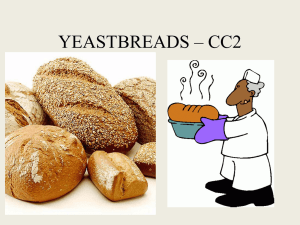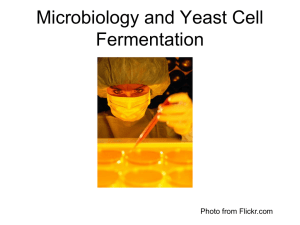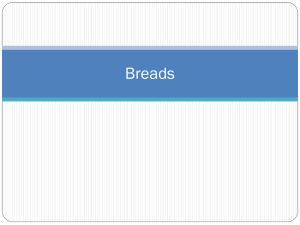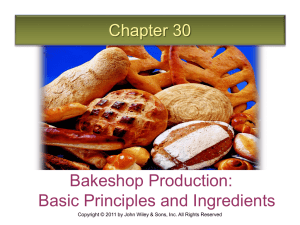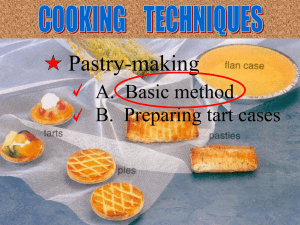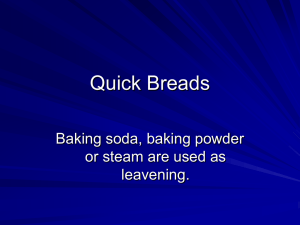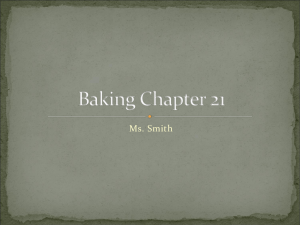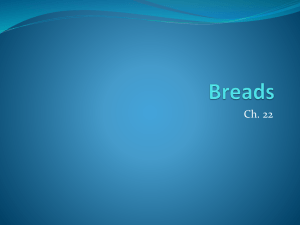Yeast Breads
advertisement
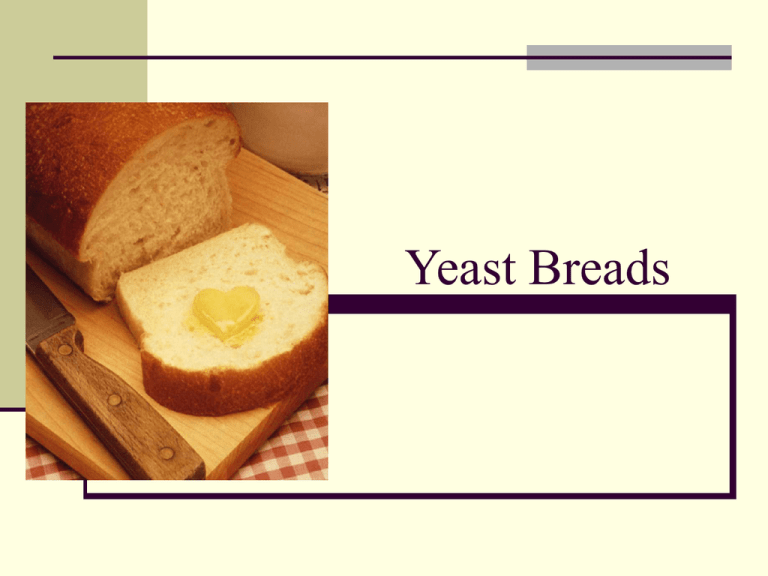
Yeast Breads Yeast Bread Basics All yeast breads must contain flour, liquid, salt, and yeast. Many recipes also include sugar, fat and eggs. You can use all-purpose flour for making yeast breads. However, many yeast bread recipes call for bread flour. Bread flour contains more gluten than all-purpose flour. When mixed with liquid and kneaded, the flour develops gluten which supports the carbon dioxide produced by the yeast. Liquids in Yeast Breads You can use plain water, potato water, or milk as the liquid in yeast breads. You must warm all liquids to activate the yeast. Milk adds nutrients to bread and helps bread stay fresher longer. It also gives bread a softer crust. Some yeast bread recipes state that you should scald the milk. This step is unnecessary if you are using pasteurized milk.(Unpasteurized milk contains enzymes that can cause doughs to soften during fermentation). Temperatures If you will be dissolving the yeast in water, heat the liquids to 105°-115°. If you are combining yeast with other dry ingredients, heat the liquids to 120°-130°. Temperatures that are too high will kill the yeast cells. Temperatures that are too low can slow or stop yeast activity. When preparing bread in a bread machine, liquids should be at room temperature (75°-85°) Salt in Yeast Breads Salt regulates the action of the yeast and inhibits the action of certain enzymes in the flour. Without salt, a yeast dough is sticky and hard to handle. Yeast Yeast leavens bread. Use the amount of yeast specified in the recipe. Using too much yeast will cause the dough to rise too quickly. Temperatures affect yeast cells. Temperatures that are too high will kill the yeast, temperatures that are too low will slow down or stop yeast activity. Types of Yeast Fresh Yeast-also called compressed yeast. Usually purchased in 1 lb. Cakes. Active Dry Yeast-dry, granular form of yeast. Must be rehydrated in warm water before use. Instant Yeast-also a dry granular form of yeast, does not have to be dissolved in water before use. Also called rapid rise or quick rise yeast. Other Ingredients Sugar-provides extra food for Eggs-add flavor and richness to the yeast so the dough will rise faster. If too much sugar is used, the dough will actually rise slower. Sugar also influences browning, flavor and texture. yeast breads. They also add color and improve the structure. Other ingredients can be added such as raisins, nuts, cheese, herbs, and spices. These ingredients add flavor and variety, but they may also increase the rising time. •Fat-increases tenderness. • Most recipes call for solid fat, such as shortening, butter or margarine. Some recipes call for oil.Use the type specified in the recipe. Steps in Yeast Bread Production 1. 2. 3. 4. 5. 6. Mise en place (scale and prepare ingredients) Mixing Fermentation Punching Scaling Rounding Steps in Yeast Bread Production 7. Benching-allow the dough to rest before shaping. 8. Makeup and panning 9. Proofing 10. Baking 11. Cooling 12. Storing Mixing Methods for Yeast Breads Traditional Method One Rise Method Mixer Method Batter method Cool Rise Dough Refrigerator Dough Freezer Dough Bread Machine Traditional Method Steps: Soften the yeast in warm water.(105°-115°). Add the sugar,fat, and salt to the milk. The milk should be room temperature to lukewarm. Combine the yeast with the liquid mixture, and add some of the flour . beat the mixture until smooth. Add the remaining flour gradually to form a dough. You can also use the traditional method to prepare refrigerator yeast breads. These breads often call for extra yeast, sugar and salt. Mix and knead the dough and place in a covered bowl in the refrigerator. Shape the dough and bake it the next day. The is sometimes called the cool-rise method. Mixer Method This method works well with active dry or fast rising yeast. It also allows ingredients to blend easily and eliminates softening the yeast. Steps: Mix the yeast with some of the flour and all of the other dry ingredients. Heat the liquid and fat together to a temperature of 120°130°F, and add to the dry ingredients with an electric mixer. Add eggs, if required, and add the remaining flour to form a dough. Using the mixer helps develop the gluten and shortens the kneading time. Batter Method Uses less flour, so the yeast mixture is thinner than a dough. Vigorous stirring, rather than kneading helps develop the gluten. If the recipe requires two risings, rise first in the mixing bowl, then spread the batter in the baking pan for the second rising. Food Science Principles of Preparing Yeast Breads Preparing yeast breads requires the development of gluten and the formation of carbon dioxide. The gluten develops during mixing and kneading. The gluten will form the framework of the bread and hold the carbon dioxide produced by the yeast during fermentation. The yeast will produce carbon dioxide which will give volume to the bread. Kneading Although some of the gluten develops during mixing, kneading develops most of the gluten. To knead means to press the dough with the heel of the hands, fold it, and turn it. You must knead yeast dough until smooth and elastic. It is important not to add too much flour during kneading. Too much flour will make the dough stiff. Do not be too rough with the dough. Too much pressure at the beginning of kneading can keep the dough sticky and hard to handle. Too much pressure at the end of kneading can tear or mat the gluten strands that have developed. Kneading the Dough The dough has been kneaded enough when it passes the windowpane test. To perform the windowpane test, cut off a small piece of dough from the batch and gently stretch, pull and turn it to see if it will hold a paperthin translucent membrane. If the dough falls apart before it makes the windowpane, continue mixing or kneading for another minute or two and test again. Fermentation After kneading a yeast dough, you must allow it to rest in a warm place. During the rest time, the yeast acts upon the sugars in the bread dough to form alcohol and carbon dioxide. This is called fermentation. The alcohol evaporates during baking, the carbon dioxide causes the bread to rise. The dough should double in volume. To test to see if the dough has doubled, press two fingers into the dough, if an indentation remains, the dough has risen enough. Fermentation time varies depending on the kind and amount of yeast, the temperature of the room, and the kind of flour. The room temperature for fermentation should be 80°-85° F. If the kitchen is not warm enough, place the dough on a wire rack over another bowl filled with warm water. Punching the Dough When the dough has completed rising, you must punch it down to release some of the carbon dioxide. Punch dough down by firmly pushing a fist into the dough. Fold the edges of the dough toward the center, and turn the dough over so that the smooth side is on top. At this point, some doughs require a second rising time. Shaping After punching the dough down, use a sharp knife to divide it into portions as the recipe directs. Allow the divided dough to rest 10 minutes. After resting, the dough is easier to handle. Allow the dough to rise again after shaping. To shape dough, first flatten dough into a rectangle. The width of the dough should be about the length of the bread pan. Use a rolling pin to help you work out any large air bubbles. Cover the shaped dough and allow to rise in a warm, draft free place until they have doubled in bulk. Shaping Yeast Breads Crescent Rolls Parkerhouse Rolls Cloverleaf Rolls Baking Baking times and temperatures vary depending upon the kind of dough and size of the loaf. Place most yeast breads in a hot oven to begin baking. During baking, the gas cells expand. The walls of dough around these cells set and become rigid. During the first few minutes of baking, the dough will rise dramatically-this is called oven spring. Shortly after oven spring occurs, you may reduce the oven temperature so the bread finishes baking in a moderately hot oven. This prevents over-browning. After baking, immediately remove the bread from the pans and place it on cooling racks. Cool thoroughly before slicing and storing. Characteristics of Yeast Breads A high-quality loaf has a large volume, and a smooth, rounded top. The surface is golden brown. When sliced, the texture is fine and uniform. The crumb is tender and elastic, and it springs back when touched. If a yeast dough has been under or over worked, the finished product will have a low volume. (The carbon dioxide has leaked out of the dough.) If you allow bread to rise for too long a time before baking, it may have large, overexpanded cells. The top of the loaf may be sunken with over-hanging sides. The texture may be coarse, and crumbly. Bread that has not been allowed to rise long enough before baking may have large cracks on the side of the loaf, and the texture will be compact. Time Saving Yeast Bread Techniques Cool-Rise Doughs Prepared from recipes that are specially designed to rise slowly in the refrigerator. Mix the ingredients and knead the dough, then after a brief rest, you shape the dough and place it in a pan. Cover and refrigerate. The dough will rise and be ready to bake 2-24 hours later. Refrigerator Doughs Prepared from recipes that are specially designed to rise slowly in the refrigerator. Often uses the batter method. Shaped after refrigeration. Dough can remain in the refrigerator for 2-24 hours. Then you shape the dough, let it rise and bake it Freezer Doughs Recipes allow you to mix and knead the dough. Then you can freeze the dough before or after shaping. Store the dough in the freezer for up to one month. When you are ready to eat it, thaw, shape if necessary, let rise and bake. Bread Machines Fastest, easiest way to produce homemade bread. Each machine model behaves differently. Carefully follow the manufacturers directions. You can check the texture of the dough by opening the machine’s lid partway through the first knead cycle. The dough should form a soft ball that is somewhat sticky to the touch. If the dough is too moist, the loaf will collapse during baking. To correct, add 1 Tablespoon of bread flour at a time. Weather conditions have an effect on dough prepared in a bread machine. Microwaving Yeast Breads You can defrost frozen bread dough in the microwave. You can also raise and bake yeast bread in the microwave. Bread baked in the microwave will lack the crisp, brown crust of a conventionally baked loaf. Defrosting Frozen Bread Dough Step 1: Microwave 1 cup water for 3-5 minutes on HIGH, until boiling. Place the frozen bread dough in a greased, microwavable loaf pan. Microwave on the defrost setting for 3 min. Turn dough over and rotate the pan. Microwave on defrost for another 3 min. , until the dough is soft to touch. Allow the dough to stand for 5 min. until pliable. Raising Dough in the Microwave Oven Place dough in a greased bowl, turning to grease on all sides. Cover the bowl with waxed paper and place it in the microwave with a dish of warm water. Microwave on low power for 1 min. Let the dough stand for 15 min. Rotate the dish ¼ turn. Repeat this step until the dough is doubled. Other Types of Yeast Breads French Bread Baguettes Focaccia Other Types of Yeast Breads Challah-the traditional bread for Jewish Sabbaths and Celebrations. Rich with eggs and flavored with honey, it is braided into oval loaves and topped with poppy or sesame seeds. Other Types of Yeast Breads 1. 2 Croissants-fat is incorporated through a process of rolling and folding. 3. 5. 4. 6. Other Types of Yeast Breads Brioche-a rich, tender bread made with lots of eggs and butter. It can be a difficult dough to work with. It is traditionally made in fluted pans and has a topknot of dough Other Types of Yeast Breads The New Orleans tradition, begun in the 1870s, borrows heavily from European customs. As part of the celebration of Mardi Gras, it is traditional to bake an oval cake in honor of the three kings - the King Cake. The shape of a King Cake symbolizes the unity of faiths. Each cake is decorated in the traditional Mardi Gras colors: purple represents justice, green represents faith and gold represents power. A small baby, symbolizing the baby Jesus, is baked into each cake.
